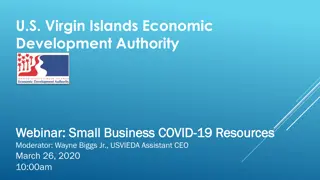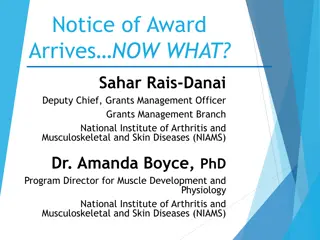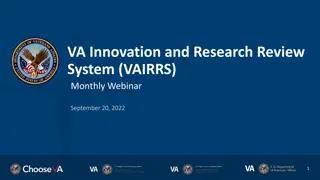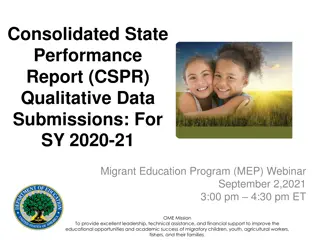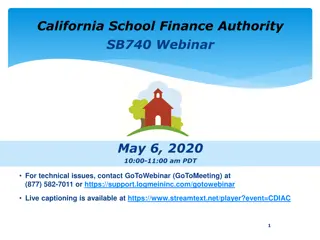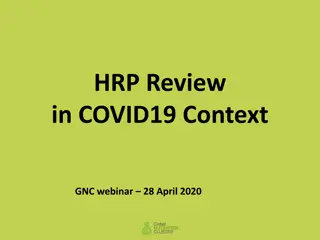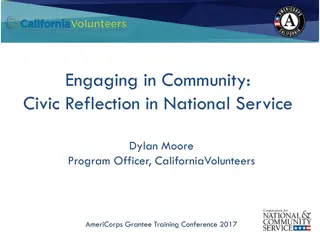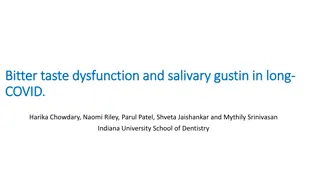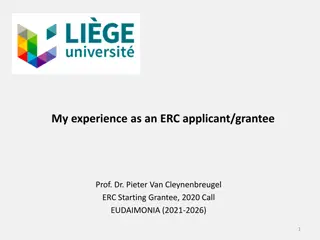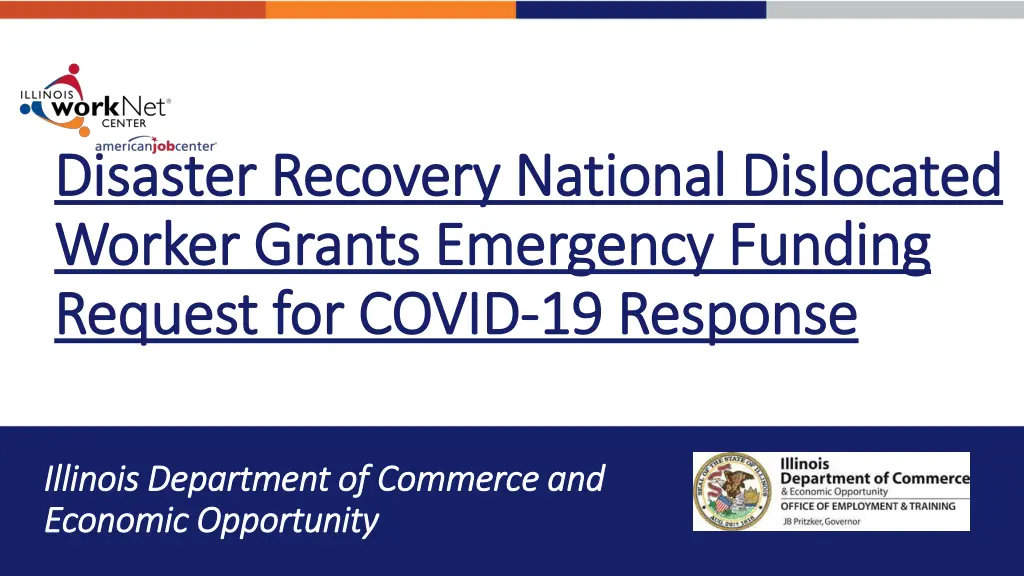
Disaster Recovery and Employment Opportunities in Illinois
Explore funding opportunities for disaster recovery and employment recovery projects in Illinois, including details on the National Dislocated Worker Program initiatives. Learn about the funding process, project elements, and how to determine funding based on needs assessment.
Download Presentation

Please find below an Image/Link to download the presentation.
The content on the website is provided AS IS for your information and personal use only. It may not be sold, licensed, or shared on other websites without obtaining consent from the author. If you encounter any issues during the download, it is possible that the publisher has removed the file from their server.
You are allowed to download the files provided on this website for personal or commercial use, subject to the condition that they are used lawfully. All files are the property of their respective owners.
The content on the website is provided AS IS for your information and personal use only. It may not be sold, licensed, or shared on other websites without obtaining consent from the author.
E N D
Presentation Transcript
Disaster Recovery National Dislocated Disaster Recovery National Dislocated Worker Grants Emergency Funding Worker Grants Emergency Funding Request for COVID Request for COVID- -19 Response 19 Response Illinois Department of Commerce and Illinois Department of Commerce and Economic Opportunity Economic Opportunity
Agenda Agenda Introductions Discussion of Disaster Recovery (DR) funding opportunity Elements of operating a DR project Elements of the application Discussion of the Employment Recovery (ER) funding opportunity Elements of operating an ER project Elements of the application Determining funding based on needs assessment Q and A (Please add all questions in the chat pod) 2
National Dislocated Worker Program National Dislocated Worker Program DWGs are time-limited funding assistance in response to major economic dislocations or other events that cause significant impact on states and local areas that exceed the capacity of existing formula funds and other relevant resources to address. DWGs are supplemental resources that provide flexibility responding and recovering from qualifying events (disasters and layoff events) The projects align with existing state and local priorities, resources, and programs including coordination with local government, emergency management agencies, social service agencies, employers and industry organizations, education, faith-based organization, public health, etc. DWGs should not be stand-alone programs, the design should coordinate with existing efforts through Rapid Response/layoff aversion, formula-funded activities, business engagement efforts, and more Expectation that projects demonstrate intent to maximize positive outcomes for participants 3
National Dislocated Worker Program National Dislocated Worker Program Illinois has submitted applications for two DWG projects: Disaster Recovery approved for $8,325,000 Disaster Recovery DWGs provide disaster-relief and humanitarian assistance employment, as well as employment and training services, as appropriate, to minimize the employment and economic impact of declared disasters and emergency situations, in disaster- declared areas as defined in 20 CFR 687.110(b). Employment Recovery application submitted to DOL awaiting funding determination Employment Recovery DWGs provide resources to respond to major economic dislocations, such as large, unexpected layoff events that cause significant job losses. Awards are determined by the demonstration of need for additional funds to provide employment and training assistance to workers affected by major economic dislocations, such as plant closures and mass layoffs. Employment Recovery DWGs provide employment and training assistance to dislocated workers. 4
Disaster Recovery (DR) Funding Opportunity Disaster Recovery (DR) Funding Opportunity Elements of Operating a Disaster Recovery Project Eligibility Disaster Relief Employment Employment & Training Case Management Support Services 5
Participant Eligibility Participant Eligibility An individual temporarily or permanently laid off as a consequence of the Covid 19 disaster or emergency; A self-employed individual who became unemployed or significantly underemployed as a result of the Covid 19 emergency or disaster; or A long-term unemployed individual as defined by the State below: An individual with a work history who is seeking employment and has been unemployed or underemployed for 10 non- consecutive weeks out of the last 26 weeks; or An individual without a work history or with a sporadic work history (e.g. temporary or seasonal employment, multiple terminations, etc.) who is seeking employment. Underemployed: An individual who is working part-time but desires full-time employment, who is working in employment not commensurate with the individual's demonstrated level of educational and/or skill achievement, who is employed and meets the definition of a low-income individual as defined in WIOA Sec. 3(36), or who is employed but their current earnings are not sufficient compared to their previous job s earnings from their previous employment. An eligible dislocated worker; (Priority is to be given to workers dislocated (temporarily or permanently) as a result of the disaster. If a person is eligible as a Dislocated Worker and also one of the other three categories above, they are to be certified/enrolled/served as a Dislocated Worker which will allow a project participant to be co-enrolled under other Dislocated Worker grants (e.g. formula) as appropriate.) 6
Grant Activities and Services Grant Activities and Services Grant Activities Although the focus of the Disaster Recovery Grant is Disaster Relief Employment, not all participants must participate in disaster-relief employment. Grantees may provide employment and training activities to participants not in disaster- relief employment. In summary, grantees may enroll Disaster Recovery DWG participants in: Disaster-relief employment only; Employment and training activities only; or Both disaster-relief employment and employment and training activities. These activities may occur concurrently, or one may occur prior to the other. Grantees must assess and determine the specific needs of each individual participant and enroll them in disaster-relief employment, employment and training services, or both, in a manner that is most likely to result in successful outcomes. As a general goal, grantees should design and provide employment and training activities aimed at allowing participants to obtain unsubsidized, sustainable employment following the conclusion of grant-supported activities. 7
Grant Activities and Services Grant Activities and Services Disaster Relief Employment (DRE) Disaster relief employment must directly relate to the effects or complications of widespread COVID-19 pandemic. DRE s created must align with the following: 1. Clean-up and recovery efforts including demolition, repair, renovation and reconstruction of damaged and destroyed structures, facilities and lands located within the disaster area and in offshore areas related to the emergency or disaster; or, 2. Employment related to the delivery of appropriate humanitarian assistance in the immediate aftermath of the disaster or emergency. Clean-up and recovery projects may perform work on private property only under authorized circumstances and with prior State approval. Humanitarian assistance generally includes actions designed to save lives, alleviate suffering, and maintain human dignity in the immediate aftermath of disasters. This assistance includes activities such as the provision of food, clothing, and shelter. The humanitarian assistance provided by disaster-relief workers must relate directly to immediate response to the disaster situation named in the DWG application and the Federal declaration. 8
Grant Activities and Services Grant Activities and Services Disaster Relief Employment (DRE) Examples of DRE positions can include but are not limited to: Delivery of food, medicine and other supplies to affected or quarantined individuals, especially the elderly and those with chronic health conditions or other vulnerabilities Helping set up quarantine areas and providing assistance to quarantined individuals Organizing and coordinating recovery, quarantine, or other related activities Contact tracing of individuals affected by COVID-19 per guidelines released by the Governor s office Providing childcare for essential healthcare workers, first responders, etc. Cleanup activities as identified and deemed necessary, including cleaning schools, etc. or sanitizing quarantine or treatment areas, etc. Healthcare workers including Certified Nursing Assistants, Phlebotomists, Lab Technicians, Medical Assisting, or Certified Healthcare Workers Manufacturing jobs to support medical supplies, devices and other COVID-19 related needs Transportation and Trucking, and Warehousing and Shipping jobs Other disaster-relief employment opportunities to be determined as they emerge throughout the crisis to address the ever-evolving needs created by the public health emergency 9
Grant Activities and Services Grant Activities and Services Disaster Relief Employment (DRE) Limitation on DRE Job Duration: A participant may hold a temporary job for no longer than 12 months or 2,080 hours. If there remains humanitarian or clean-up needs after participants reach the limits on employment duration, the grantee should attempt to employ new eligible individuals to continue the work. Participant Wages: Disaster Recovery DWGs may pay 100 percent of the salary and benefits for each participant enrolled in disaster-relief employment. Participants wages must be consistent with the wages of the supervising entity s other employees permanent or temporary performing the same or similar work but no less than the higher of the Federal, state, or local minimum wage. Fringe benefits should be paid in accordance with the policies of the worksite employer. (The employer of record needs to pay SUTA, FICA, UI and Workers Compensation). Worksite Selection: Must be located in the geographic disaster area covered by the qualifying declaration and is limited to public entities and public and private non-profit organizations. Private property can be considered under certain circumstances and must receive State then DOL approval. Participants that are only enrolled in DRE are not subject to WIOA performance. 10
Grant Activities and Services Grant Activities and Services Employment and Training and Support Services Employment and Training Services. DR projects can provide employment and training services to eligible participants following a qualifying disaster or emergency. DWG funds may provide employment and training services regardless of an individual s participation in disaster relief employment. Participants enrolled in E&T are subject to WIOA performance. Supportive Services. Supportive services are allowable when they are needed to enable individuals to participate in disaster relief employment and training services and when supportive services cannot be obtained through other programs. Supportive service policies for a disaster project must align with the state or local area supportive service policy; any supportive services provided must be consistent with WIOA. Follow-up Services. TEGL 19-16 requires that follow-up services must be provided for up to 12 months after the first date of employment for Adults and Dislocated Workers who are placed in unsubsidized employment. Follow-up services are designed to help individuals retain employment, earn wage gains, or advance within their occupation. 11
Grant Activities and Services Grant Activities and Services Employment and Training Services Career Services, including Follow-up Services (includes but not limited to) Assessment Development of an IEP Soft skills training Career planning and job coaching Training Services and Work-Based Training Occupational Training through ITAs Work-Based Training OJT Customized training Work experience/internships Transitional jobs (limited to 10%; a waiver to increase has been submitted to DOL) Apprenticeships Supportive Services Provisions for DRE Child-care, transportation, emergency assistance Education supports Job placement supports 12
Employment Recovery (ER) Funding Opportunity Employment Recovery (ER) Funding Opportunity Participant Eligibility Dislocated worker as defined in WIOA Section 3(15). Grantees are encouraged to prioritize services to individuals impacted by the qualifying layoff events where possible, but any eligible participants may be served. Trade-affected workers may receive DWG-funded training if their required training is not covered by the TAA Program. Allowable Activities Employment and Training Assistance. For Employment Recovery DWGs, the term employment and training assistance includes career services, training services, supportive services and follow-up services. 13
Employment Recovery (ER) Funding Opportunity Employment Recovery (ER) Funding Opportunity Employment Recovery Services Career Services. Career services are described in WIOA Sec. 134(c)(2); 20 CFR Part 680; and TEGL 16-16 Section C. These include several services and activities to help support dislocated workers in making informed decisions based on local and regional economic demand for the purpose of achieving reemployment and education goals. These include but are not limited to: outreach, intake, labor exchange services, initial and comprehensive assessments, development of an individual employment plan, referral, provision of labor market information, provision of information on eligible training providers, and provision of information on the availability of supportive services. Training Services. As described in WIOA Sec. 134(c)(3)(D), and may include: occupational training, on-the- job training (including apprenticeships), entrepreneurial training, and customized training. DWG funds may be used to reimburse up to 50 percent of the wage rate for on-the-job training or up to the reimbursement percentage the Governor or local board has approved for on-the-job training for WIOA formula programs according to the criteria outlined in WIOA Sec. 134(c)(3)(H) and 20 CFR 680.730. The use of DWG funds for training is subject to the limitations or requirements as applicable to the WIOA Dislocated Worker formula program delineated in 20 CFR part 680 and TEGL 19-16, Guidance on Services Provided through the Adult and Dislocated Worker Programs under the Workforce Innovation and Opportunity Act (WIOA) and the Wagner Peyser Act Employment Service (ES), as amended by title III of WIOA, and for Implementation of the WIOA Final Rules. 14
Employment Recovery (ER) Funding Opportunity Employment Recovery (ER) Funding Opportunity Employment Recovery Services Supportive Services. Supportive services are allowable when they are needed to enable individuals to participate in disaster-relief employment and employment and training services and when supportive services cannot be obtained through other programs. Supportive service policies for a disaster project must align with the state or local area supportive service policy; any supportive services provided must be consistent with WIOA. Needs-Related Payments (NRPs). NRPs are a category of Supportive Services. As defined in WIOA Sec. 134(d)(3), NRPs are allowable for DWG participants who are unemployed and do not qualify for (or have ceased to qualify for) unemployment compensation to enable them to participate in training services. NRPs offered under a DWG must adhere to state and local area policies and procedures in place for all participants. Policies and procedures may not be specifically created for DWG participants. Applicants who plan to offer NRPs to DWG participants must include a copy of the applicable NRP policies as part of the grant submission. If the dislocated worker has ceased to qualify for unemployment compensation, they are still eligible for NRPs if they meet the 13-week deadline for enrollment in training requirement described in WIOA Sec. 134(d)(3)(B) and 20 CFR 680.950. 15
National Dislocated Worker Performance Indicators National Dislocated Worker Performance Indicators Performance WIOA performance indicators apply to DR and ER projects. Measure Description Percentage of participants who are in unsubsidized employment during the second quarter after exit. 1.Employment Rate Second Quarter After Exit Percentage of participants who are in unsubsidized employment during the fourth quarter after exit. 2. Employment Rate Fourth Quarter After Exit Median earnings of participants who are in unsubsidized employment during the second quarter after exit. 3. Median Earnings Second Quarter After Exit One exception is for participants that are enrolled in Disaster Relief Employment Only. Percentage of participants enrolled in an education or training program who attain a recognized postsecondary credential or a secondary school diploma during participation or within one year after exit. 4. Credential Attainment Percentage of participants during a program year who are in an education or training program that leads to a recognized postsecondary credential or employment and who are achieving measurable skill gains. 5. Measurable Skill Gains Retention with the same employer in the 2nd and 4th quarter after exit. 6. Effectiveness in Serving Employers 16
Project Oversight, Management and Monitoring Project Oversight, Management and Monitoring Cost Limitations Administrative Cost both Direct and Indirect cannot exceed 10% of the award. Monitoring of Expenditures and Performance Expenditure will be monitored monthly to determine rate of expenditure. Performance will be monitored on a monthly basics to determine progress to meeting goals. 17
Grant Terms and Information Grant Terms and Information The DR Grant Term is from 6/1/2020 3/31/2022. The ER Grant Term is to be determine. Deadline for the application and attachments is June 15th or before. Please communicate with OET when you have questions while completing the application. This is not a competitive application and OET can assist you with the process. DOL Resources: TEGL 12-19 https://wdr.doleta.gov/directives/corr_doc.cfm?docn=9054 TEGL 14-18 Training and Employment Guidance Letter 14-18 Aligning Performance Accountability Reporting, Definitions, and Policies Across Workforce Employment and Training Programs Administered by the U.S. Department of Labor (DOL) https://wdr.doleta.gov/directives/corr_doc.cfm?docn=7611 Attachment 6 National Dislocated Worker Grant Program Attachment 6 of TEGL 14-18: https://wdr.doleta.gov/directives/attach/TEGL/TEGL_14-18_Attachment-6_Acc.pdf Application and Resources are available on Illinois workNet at https://www.illinoisworknet.com/NEG 18

